Blog
October 11th, 2010
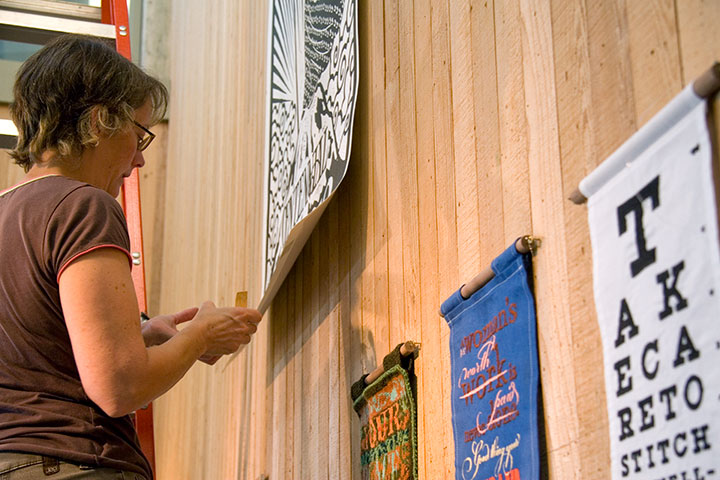
While I’ve been hiding away, wrangling my 900-pound gorilla, Jessica has been cooking up something pretty great.
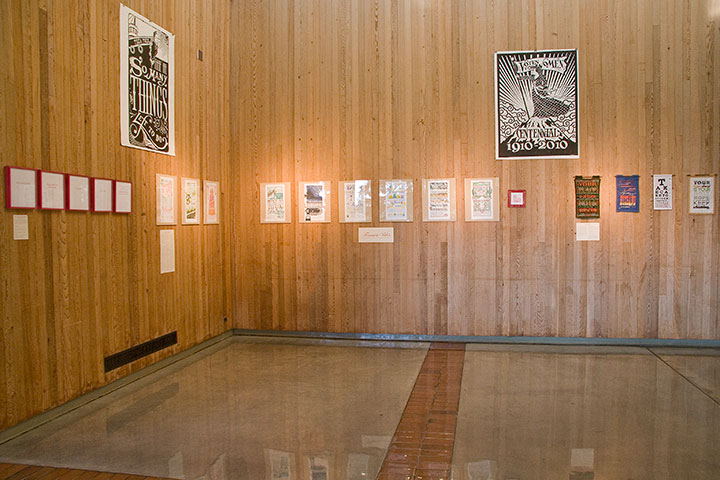
Thanks to her hard work and the wonderful Brian Hutcheson‘s invitation, we are pleased as punch to announce our first-ever dual exhibition!
Feminist Wiles: Jessica Spring and Chandler O’Leary
Now through November 5
Ted Sanford Gallery, Charles Wright Academy
7723 Chambers Creek Rd. W
Tacoma, Washington
Open 8 to 5, Monday through Friday
It seems weird that after more than two years of collaborating, giving lectures and printing in the street, we’ve never had an honest-to-goodness show together.
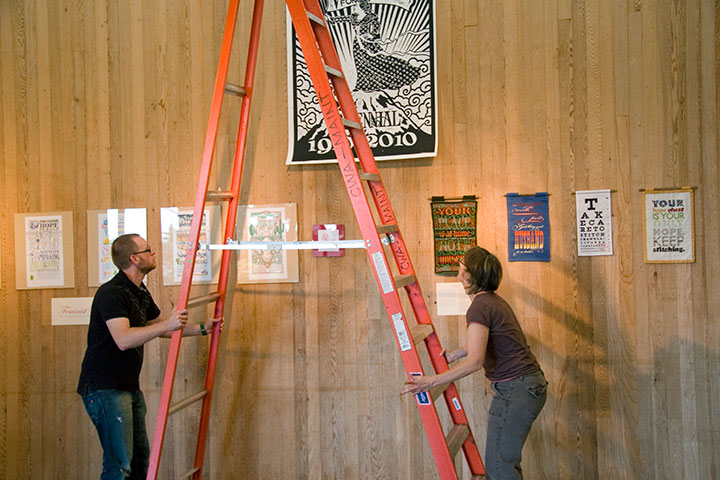
But when Brian offered us a cavernous space, his help with installation, and the chance to indoctrinate the innocent introduce our series to the kids at Charles Wright—well, we’d be nuts to pass that up.
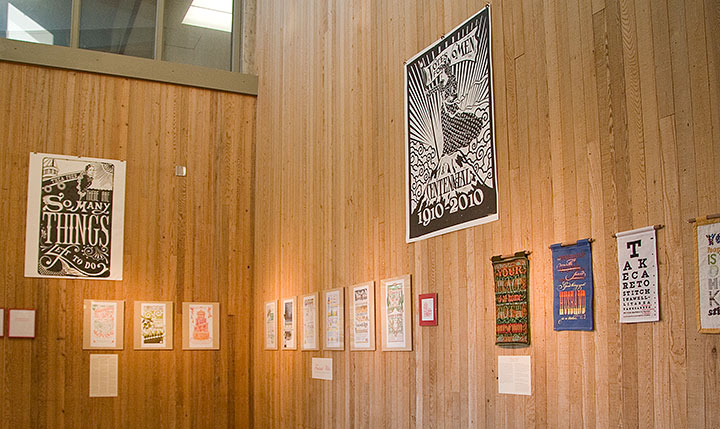
For the first time, all nine (and-a-half) Dead Feminist broadsides to date, plus our two steamroller gals, are on display together.
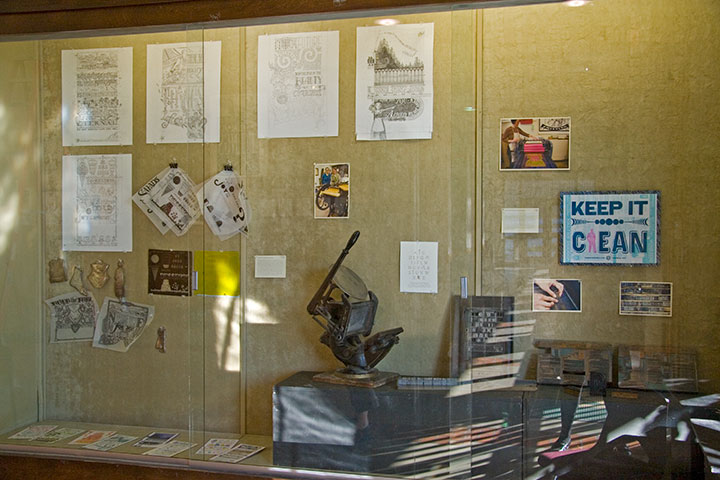
We also have a little mini-exhibit about our process,

and lots of little goodies to introduce people to letterpress.
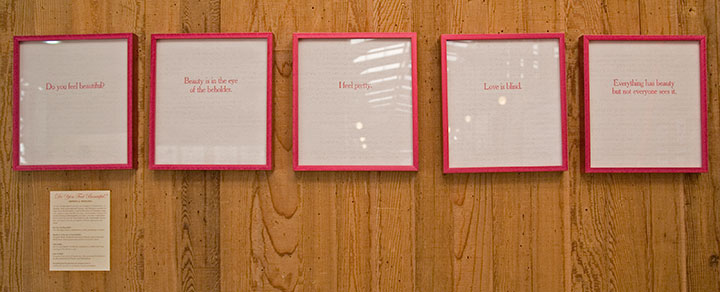
Jessica and I have rounded out the collection with solo work that complements the theme of the show. Jessica’s half consists of Do You Feel Beautiful?, a series of broadsides featuring famous aphorisms on beauty. Here’s the thing that blows my mind into tiny pieces every time I think of it: the quotes are letterpress printed on the pages of a Braille edition of Seventeen magazine. Whoa.
I contributed Women’s Work, an ongoing series of broadsides created in hand-sewn textiles rather than my usual letterpress.
Now, I get a ton of questions about these things whenever I show them, so I thought I’d outline the ideas and process behind them here.
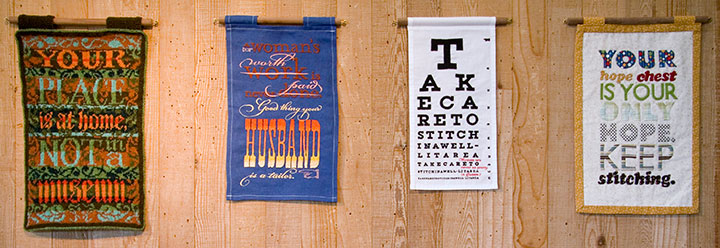
The Tailor first sparked the idea for the series; as you know, he makes his own clothing (hence the nickname). This is a feat that never ceases to amaze me, and I’m not the only one—he gets a lot of comments, usually along the lines of “Wow, you made that?” He’s always a little surprised by these comments, because where he grew up, a lot of people (including his family) wore homemade clothing. That got me thinking, though. The people who do all that sewing in the Tailor’s hometown are women—mothers, grandmothers, sisters, daughters, wives. We’re all surrounded and preceded by generations of women who sew clothing, or knit sweaters, or draft patterns from scratch, without any rave reviews—or any comment at all. But every male knitter or quilter I’ve known, every rare and wonderful man who ever picked up a needle, is either looked at like he’s nuts, or treated with reverent awe. It strikes me as a little strange that depending on who made it, and who’s looking at it, a pair of pants can be a work of art—and an actual work of art can be completely ignored.
If you go further back, like, I dunno, throughout the entirety of human history—you’ll find that both men and women have been responsible for creating textile goods in nearly every culture on earth. Yet in almost every case, when men made textiles it was as part of some sort of guild craft or other professional setting. When women made textiles, it was as part of the home front. This is true in every part of the globe, in pretty much every era, going back to the advent of textile technology.
No matter who does the stitching, there’s an enormous amount of technical skill and design sensibility required to make a garment or textile object. So instead of creating divisions and pigeonholes—instead of separating into Art and Not Art, into Man-made and Woman-made, what if we started seeing the inherent worth in the objects themselves? And what happens when we take a handmade textile and stick it in a gallery? Does its perception change?
Based on what I’ve seen so far with these broadsides, I’d say it does. It’s been an interesting experiment, for sure.
So the Women’s Work series is a bit of an indictment of the double standard, and while the snark is aimed at a wider target, I wrote them as if I were speaking to a woman. Each one is completely made/knitted/sewn/pieced/embroidered/etc. by hand, from design to pattern to construction. The text reads in the voice of a disapproving female role model (or the insidious voice inside our own heads)—in the tone of the backhanded compliment, the cheerful put-down. Each is also designed in the style of a traditional letterpress broadside, to put the typography within the context of an art form centered around mass communication.

This guy requires a little more of an explanation for folks who aren’t already into wool.

This piece, made almost three years ago now, is hand-knitted with Shetland wool, using the traditional Fair Isle knitting technique. Fair Isle—a method practiced since the nineteenth century on the tiny island of the same name, halfway between Scotland and Norway—is a tricky, rather ingenious thing. Traditional Fair Isle pieces are knit with two colors of yarn at the same time; the resulting fabric is durable, extremely warm, and great for any chilly, foggy, wet climate (like, hello, here). Beyond its über-practicality, Fair Isle knitting is simply gorgeous (take a gander at Google). By nature the double-thick fabric is dense and flat, making it an ideal ground for complex patterns and designs—it’s the perfect mix of function and fancy.
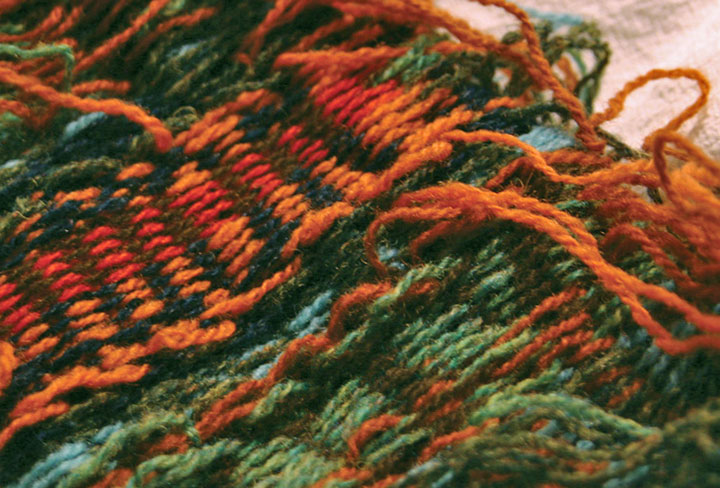
Here’s how it works: even though the piece is knitted with two different colors of yarn at once, only one strand at a time ever passes through the needles. The unused strand of yarn is carried loosely, or “floated,” behind the work—which creates a reversed-out image of the design on the back of the piece. It’s the floats that give structure to the fabric, and make it so cozy-warm.
If you were to create a plain ol’ piece of ordinary knitting, you’d proceed from one end to the other of a row, flip the piece over, and work back the other direction. Rinse and repeat. If you tried that with a piece of Fair Isle knitting, working the “wrong” side would be extremely difficult, since the floats would now be facing you and covering your stitches. Now comes the tricky, smarty-pants part. Flat Fair Isle pieces are first knitted up into a big round tube, and then cut to lie flat. When you knit in the round, you never encounter the wrong side of the work. You just spiral around and around on the right side, happily knitting away and floating the unused color behind you as you go.
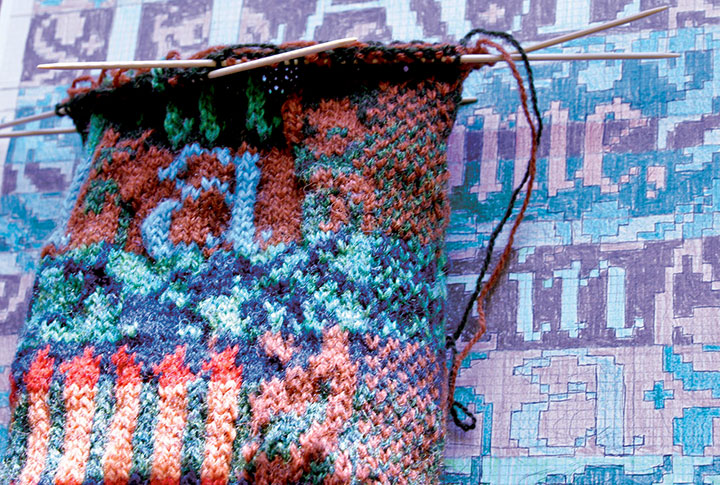
So in this case, once I had drafted my design into a gridded stitch pattern, I just pretended I was knitting one really big sleeve (or a neck warmer for a giraffe) with really teeny needles.
Ah, but remember the operative words above: you have to cut the piece to finish it. I had never done this before, and let me tell you, there’s an awful, terrifying finality to the idea. Torn sweaters unravel. Snagged socks fall apart. Who in their right mind would cut a piece of knitting on purpose? And even if you could do it, what happens if you make a mistake? Once you make that cut, you’re done.
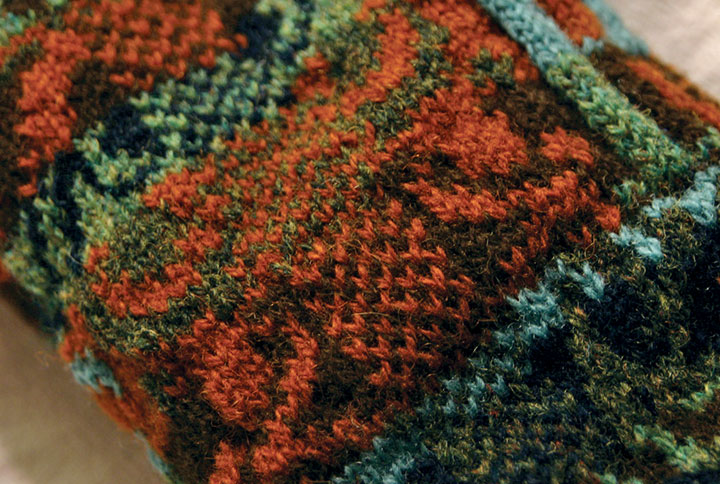
This is where the true brilliance of the technique hit me like a ton of bricks. The Scotswomen of Fair Isle are a breed apart—and so are their sheep. Shetland wool, the material traditionally used in Fair Isle knitting, has a magical property that makes this crazy notion work: each wool fiber is covered with microscopic scales that attach to one another. Because the wool sticks to itself, the stitches become slightly matted as you knit. So following the Fair Isle method, you work a little buffer zone called a steek (see the checkerboard strip above?) into your design, and then cut right down the center of the steek. If you use trusty Shetland wool, your stitches won’t unravel when you cut them.
At least, that was the theory. I didn’t quite believe it at the time. But I’d come this far—I didn’t want to lose faith. (If you’re looking to try Fair Isle knitting yourself, I find a glass of wine helps.) So I took a steadying swig, held my breath, and cut.
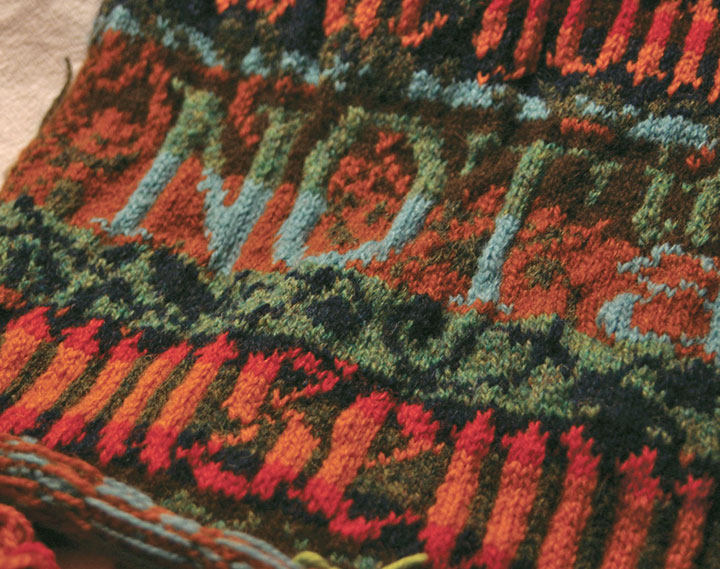
And then I exhaled. And blinked. I had a flat piece. Gingerly I tested the cut edge—and was amazed. Even with a fair bit of tugging, the stitches refused to unravel.
I will never question a Scotswoman again.
My favorite thing about all of this, beyond the magic of Fair Isle itself, is that knitting really lends itself well to letterforms. Even though the pattern is drafted out on a grid, the forgiving nature of knitted stitches turns every square on the grid into a slightly curved, irregular shape. So when you zoom out and look at the piece from a distance, those grid “pixels” turn into nice little serifs, curves and curlicues.
The rest of the broadsides in the series are made using other types of needlework (more on that in the next post), but the knitted piece is still my favorite. I think I need another dose of that Fair Isle magic in my life—maybe next year you’ll find me up to my knees in wool again.
(Read about the rest of the “Women’s Work” broadsides in part two.)

September 15th, 2010

Lately I’ve spent nearly every waking minute of each day with my face an inch away from the drafting table.
Let’s step back, and stretch out a bit.
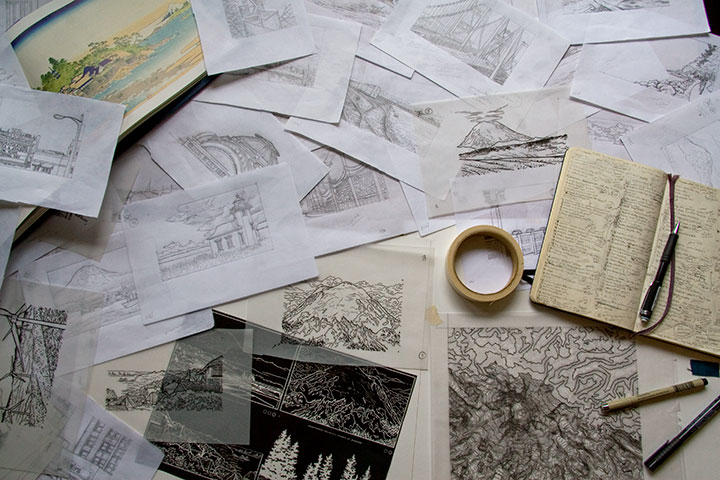
My studio is often a sea of papers—an occupational hazard—but these days the swells have consisted of pencil snapshots for my Mt. Rainier book. Dozens, and dozens, and dozens of them.
Time is ticking down, counting closer and closer to zero, and there are still many miles to cover before the clock strikes deadline. Yet suddenly, things are starting to come together. It won’t be long until I can share something that makes sense—something that looks more like a book, and less like a pile of drawings. I promise that you’ll be among the first to see it when I do.

But if I go missing for long stretches at a time—well, you know where to find me.
August 31st, 2010
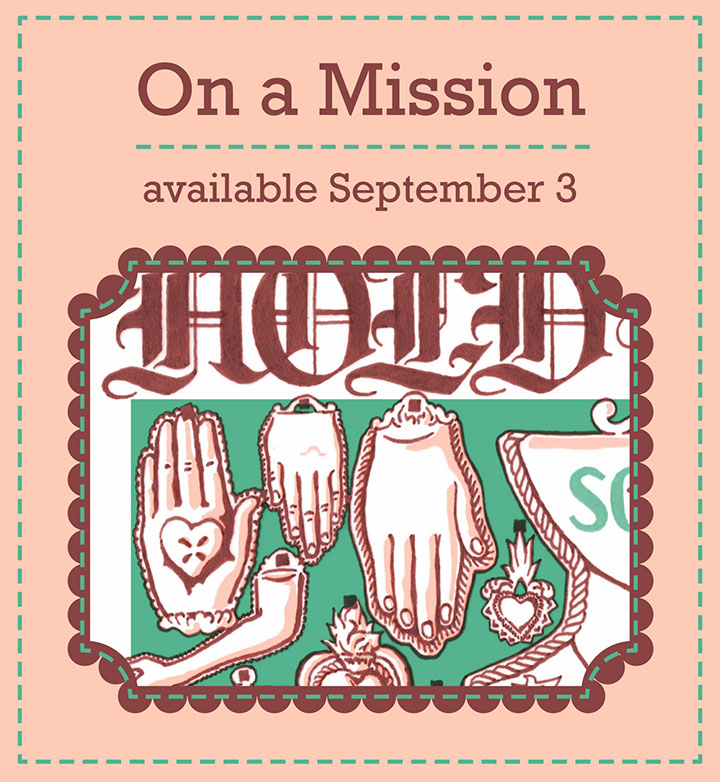
At the Wayzgoose on Saturday (thanks to the hundreds of folks who showed up!), Jessica and I had a little teaser for the next Dead Feminist print set up at our table—I figured it wouldn’t be fair if I didn’t also share it online.
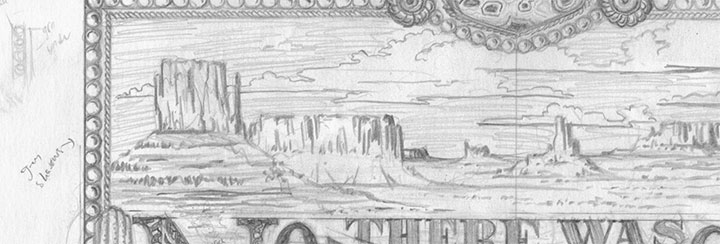
I’m not going to say much, so as not to spoil the surprise, but I thought I’d drop a few clues by way of my messy drawings—
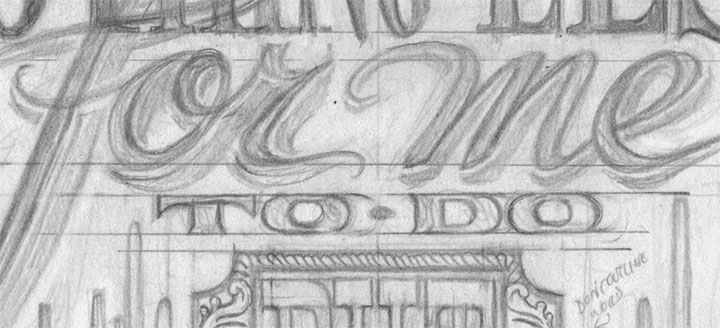
warts and all. As you can see by all the smudges and arrows, doin’ it by hand is hardly a perfect process,
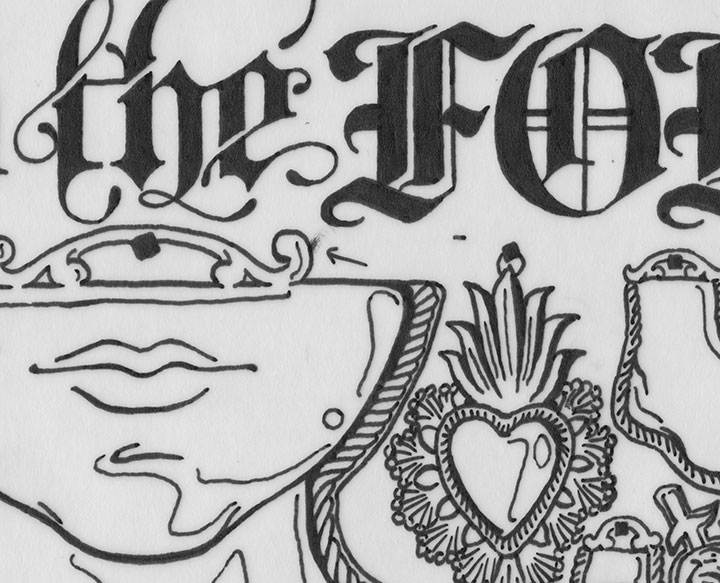
but I wouldn’t have it any other way.
On a Mission is on press as I speak, inching closer to the finish line every moment. Look for it here on Friday—see you then!
August 11th, 2010
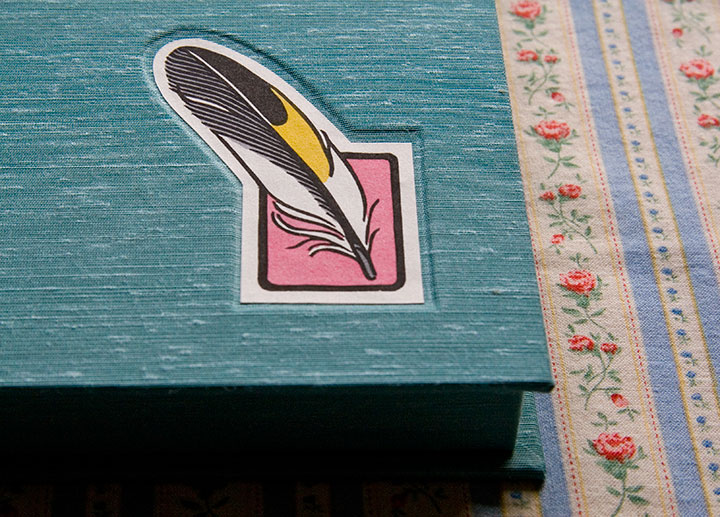
I’ve been sitting on this post for months now—it’s just that after spending so much time hunched over this project, I needed some time off from even thinking about it. But now I’m ready to talk birds again.

From left: Cedar Waxwing; Steller’s Jay; American Avocet; Purple Martin; Tufted Puffin
Eighteen months, twenty-five birds, six hundred twenty-five individual prints and ten box sets later, my little Flock is finished.

Mountain Quail; American Bittern; Long-billed Curlew; Hooded Merganser; Laysan Albatross

Barn Owl; American Kestrel; Eurasian Coot; Anna’s Hummingbird; Herring Gull
It’s a little crazy to see these all together, like, well, birds on a wire. Each one has been broken down into its own little assembly line for so long that I forget sometimes to see them as a set.

Western Tanager; Lazuli Bunting; Northern Flicker; Bullock’s Oriole; Belted Kingfisher

Common Loon; Marbled Murrelet; Northern Shoveler; Harlequin Duck; Brown Pelican
As you can see, what’s represented here is a pretty broad cross-section of Washington birds. There are so many bird species ’round these parts, in fact, that I almost didn’t know where to start—and narrowing the choices down to twenty-five was by far the most difficult task.
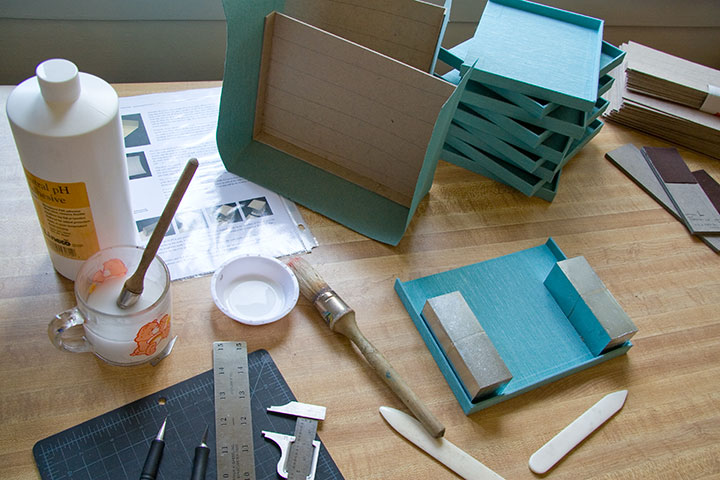
Wait. I take that back. The hardest part was keeping the glue off of the pricey imported Japanese book cloth (glue plus cloth equals death—or at least wailing, gnashing of teeth, and starting all over from the beginning).

You see, it seemed silly to have a set of prints with nothing to house it. My inner book artist took over (thanks to Jessica’s tricksy enabling), and insisted on encasing the first ten sets of the edition in handmade clamshell boxes.

Even though the results are always worth it, I don’t have much love for making boxes—what I do love is printing the colophon. A colophon (or in today’s hardbound novels, the “note on the text”) is an essential element in any artist’s book; this is where the artist steps outside the book’s content and talks about the making of the book itself. For this I decided to go back to my letterpress roots, and hand-set the text in metal type.
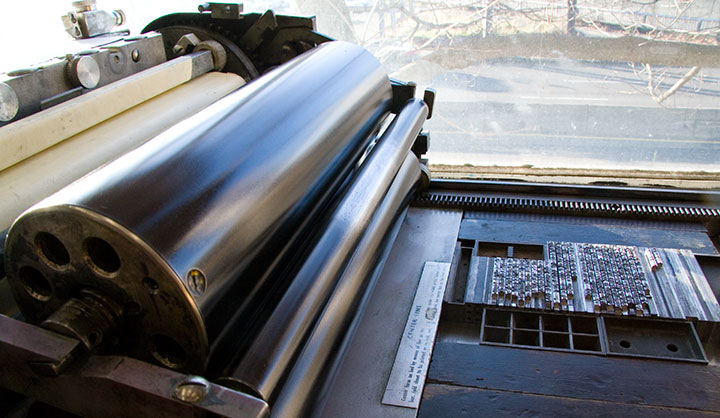
While I’m rarely able to fit hand-setting into my projects these days (a drawback to all the lettering I’ve been doing), it’s still my favorite method of getting a block of text onto a page. And this beloved Bembo, cast locally at Stern & Faye, is so beautifully spaced and balanced that it’s a dream to set and a pleasure to read.
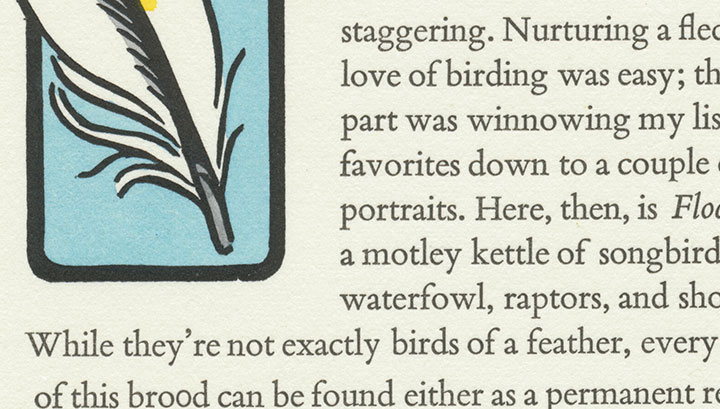

Here’s what it says:
The sheer variety of avian species here in the Pacific Northwest is staggering. Nurturing a fledgling love of birding was easy; the hard part was winnowing my list of favorites down to a couple dozen portraits. Here, then, is Flock, a motley kettle of songbirds, waterfowl, raptors, and shorebirds. While they’re not exactly birds of a feather, every member of this brood can be found either as a permanent resident or a passing traveler in Washington state—with just a wingtip of artistic license, that is.
Printed from October 2008 to December 2009 on a gaggle of presses, including Vandercook models SP15 and Universal One, a Craftsman 6.5 x 10 platen, and my little Kelsey 3 x 5—at the School of Visual Concepts in Seattle, Springtide Press in Tacoma, the University of Puget Sound, and here at Anagram Press, respectively. The colophon is hand-set in Bembo, and each hand-carved linocut print is hand-painted with Pelikan watercolor (no pun intended). Of a covey of 25 birds, a tweet of 25 prints each, and a parliament of ten box nests, this is number [2].
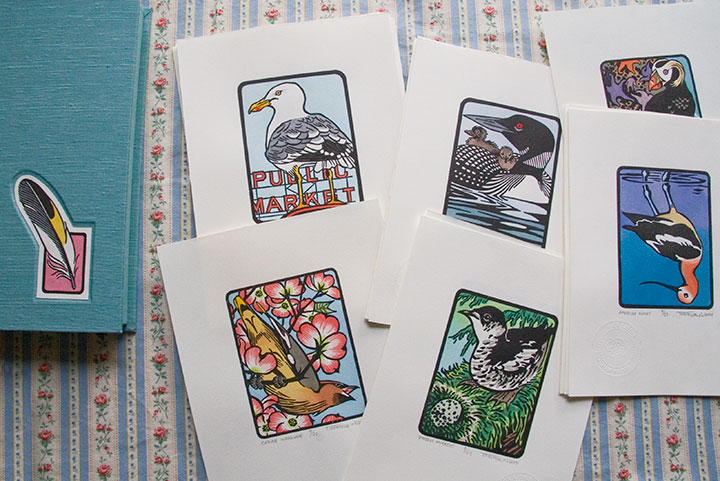
Okay, so maybe I went a bit overboard on the avian puns. It’s just that the thought of getting my hands dirty on type drawers again had me all twitterpated.
And I have a fluttering feeling that there might be even more birds in my future—one of these days, anyway.
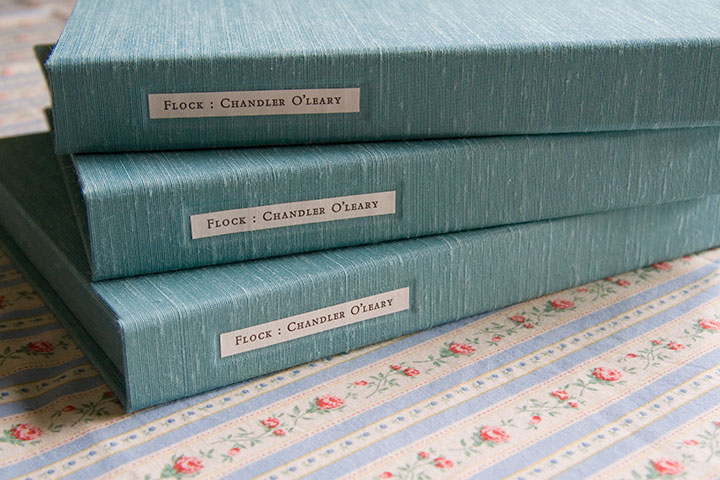
June 3rd, 2010
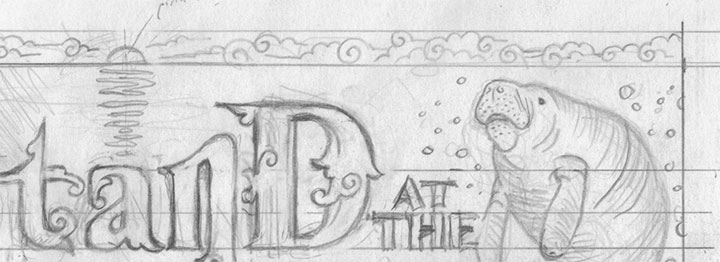
The next print in our Dead Feminists series will be making its in-person debut on Tuesday—these few snippets might give you a clue as to our latest theme. Jessica and I will be doing our dog-and-pony show at the Gig Harbor branch of the Pierce County Library; if you’ve missed our previous lectures, come check it out! If you have seen seen it, you’ll already know our schtick, but you’ll still get to see the new piece first! As always, you can also get up to speed by reading about our process here.
Pressing Matters: local letterpress artists combine craft with history
Tuesday, June 8, 2010
7:00 p.m., free!
Gig Harbor Branch, Pierce County Library
4424 Point Fosdick Drive NW, Gig Harbor, WA

We’re a month late with the new broadside for a couple of reasons. The longest (4 months!) and most annoying delay came from the fact that we’ve had to switch to a different paper. I know that sounds silly, but the paper industry is very volatile, and if you’ve ever used a type of paper that you love, only to have it be discontinued (or worse, the company goes out of business), you’ll know how frustrating it can be to find a reasonable facsimile. I guess we should have seen this one coming—the paper we’ve been using is not only extremely unusual (made from recycled clothing!), but it’s also made by a tiny, independent paper company. It’s a long story, but the short version is that the paper is now perpetually on back-order, and we had begun to notice quality issues. So! We’ve finally found a very good, high-quality replacement, and while it doesn’t quite have the Cool Factor of the other stuff, we certainly have a lot less to worry about.

The broadside will appear online (both here and in the shop) on Wednesday, so stay tuned for more information. And in the meantime, in case you’re debating whether it’s worth the Sturdy Gertie bridge toll to attend the talk, you can say hello to the giant octopus* on the way!
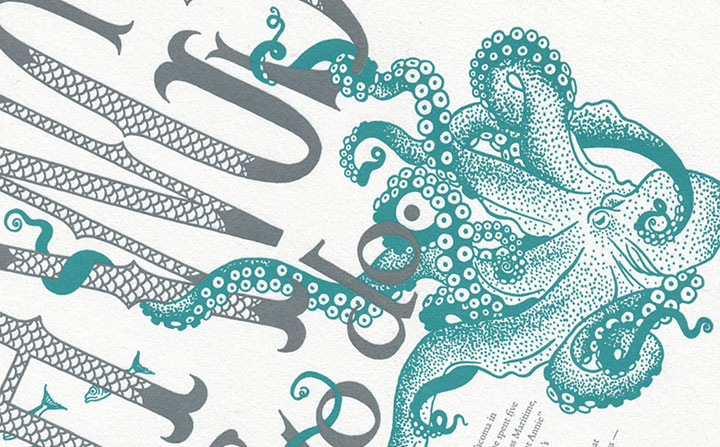
*I just learned that one of the world’s largest species of octopus lives in the Tacoma Narrows, right under the bridge—a fact that completely made my week, and that I’ve obviously been dying to work in to a blog post.
April 18th, 2010
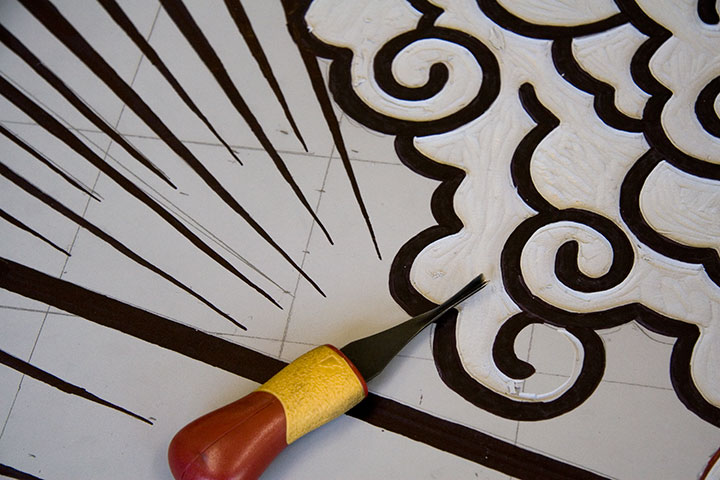
Jessica and I are carving like mad this week, getting ready for some quality steamroller time.
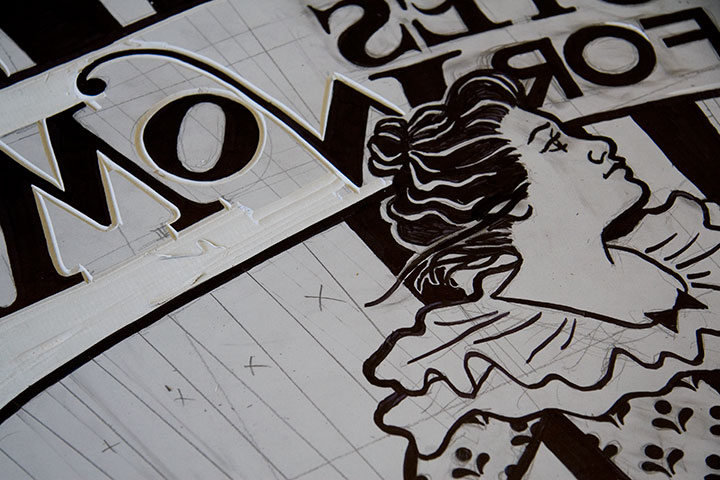
Next Sunday, April 25, is the sixth-annual Wayzgoose at King’s Books, right here in Tacoma. This year promises to be the biggest hullabaloo yet, with letterpress magnetic poetry, B.Y.O. t-shirt printing, papermaking demos, artist tables, and the star of the show: steamroller printing! Last year over 500 people came to check it out, despite a torrential downpour—and this year, the weather just might promise to behave, so we’re bracing for a mob. There’s a reason for the crowds: this is a heckuva lot of fun. Here’s the skinny:
6th Annual Wayzgoose!
Sunday, April 25, 2010
Noon to 4 pm
Free!
King’s Books
218 St. Helens Ave., Tacoma
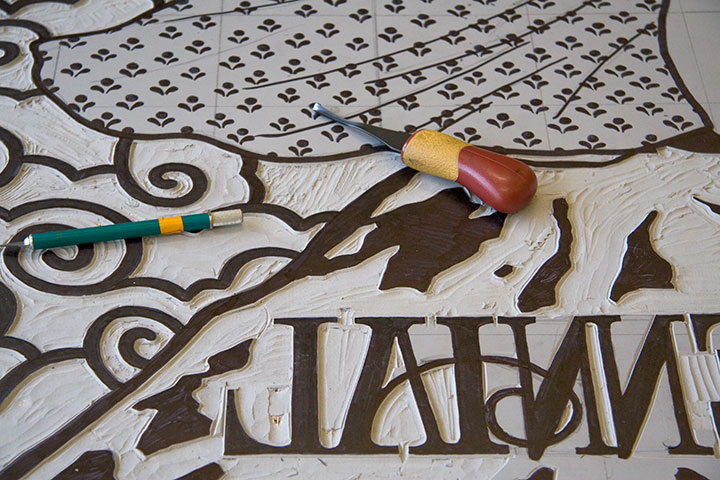
Eight artists and artist-teams will be printing gigantic three-by-four-foot linocuts in the street, including Jessica and me—we’ll be adding another unofficial Dead Feminist to our roster. (Take a gander at our last steamroller print here.) This is just a sneak peek; stop by next Sunday to see this block in action.
See you there!
January 26th, 2010
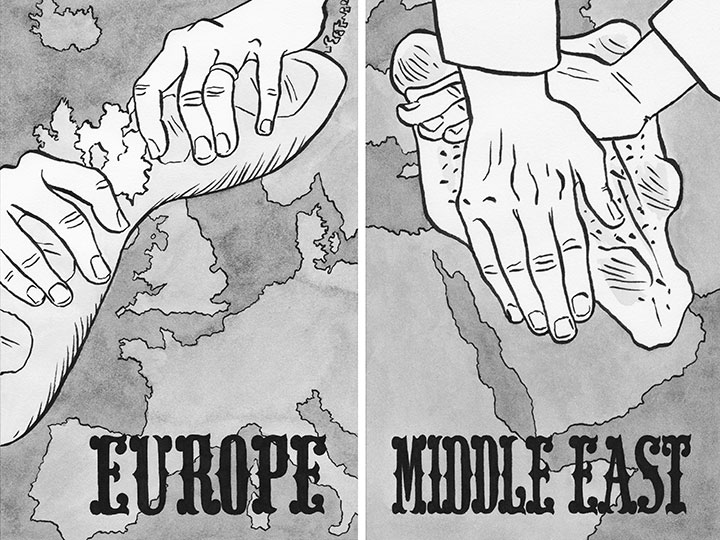
I’m currently working on the illustrations for a cookbook being published this year, so I’m drawing a whole lot of hands lately. Hands carrying dishes, maneuvering chopsticks, folding samosas, kneading dough, etc.

Since I usually work by myself, I often have to be my own model. For the most part, this works out fine, but hands are a tricky business—especially when you need to draw both hands at once, and you need one to operate a pencil.

Enter the lovely Zooey—who could both photograph my hands for me and be hand model herself. We took turns ripping a baguette to shreds for the camera (to mix up the hand anatomy), and mimed with nearly every dish in the house, just in case.
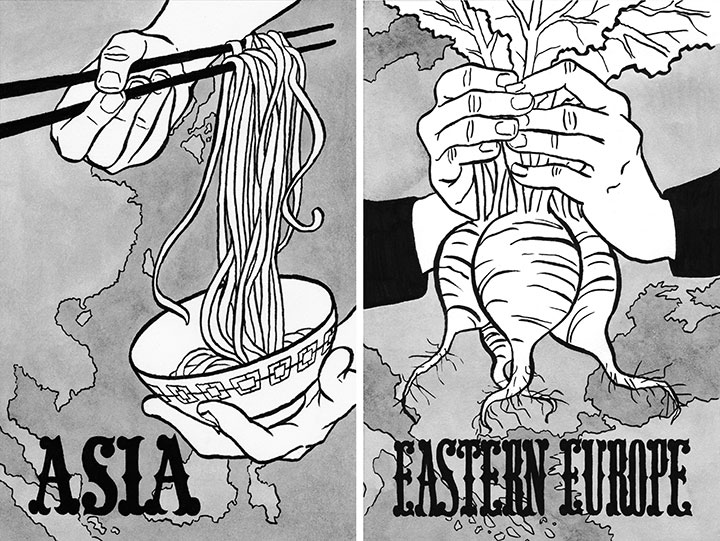
I can’t tell you how helpful it’s been to have her here while I’ve been doing these illustrations. Whenever something wasn’t quite right, I could say, “Hey, Zooey, can you pick up those chopsticks again? I need to sketch a different angle.” And Bob’s your uncle, I’d get what I needed.
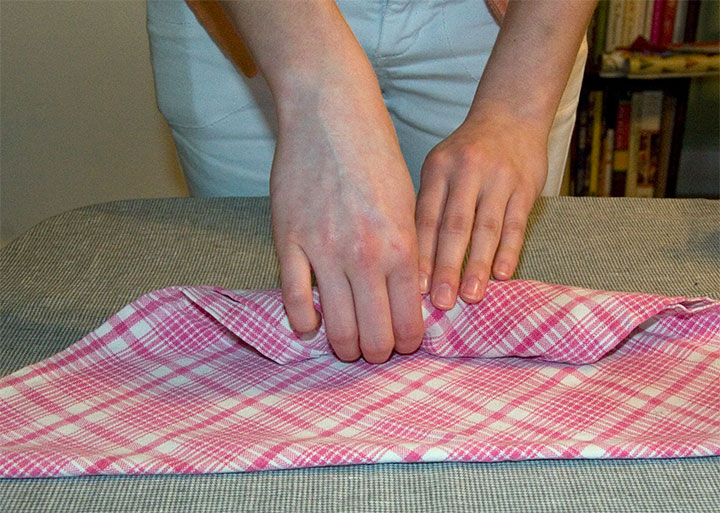
This week we spent a couple of afternoons shooting reference photos. Zooey rolled and unrolled pretend spring rolls made of fabric and made “samosas” with a scrap of denim.
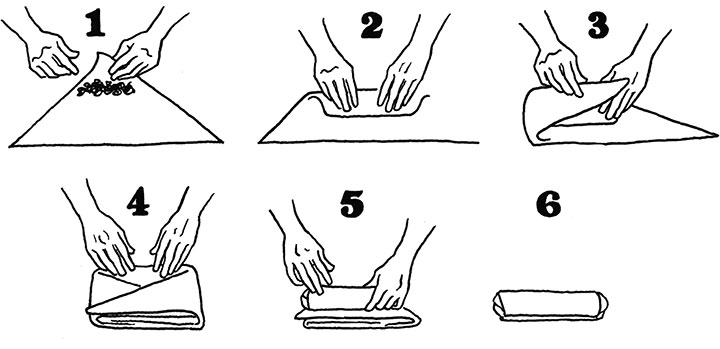
It was probably tedious for her, but the end result was a bunch of instructional illustrations that actually made sense!
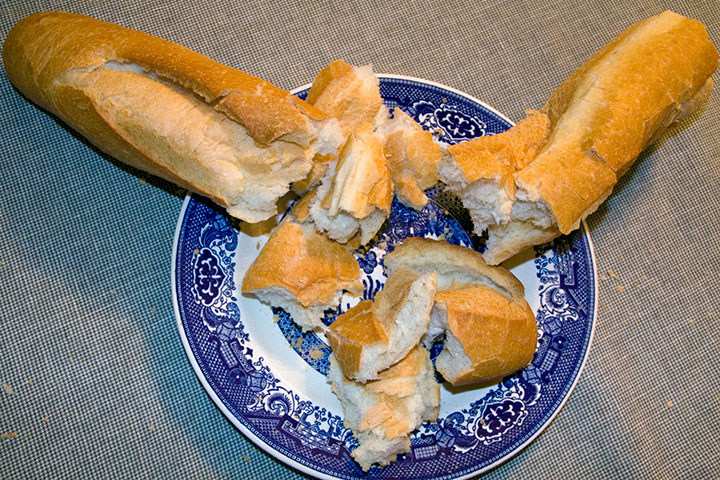
And we made a mess of the bread (doesn’t make it taste any less good!), but Zooey can say she has some pretty, uh, unique on-the-job training under her belt.
• • • • • • • • • • • • • • • • • • • • • • • • • • • • • • • • • • • • • • • • • • • • • • • • • • • • • • • • • • • •
In other news, I did a little website tweaking over the weekend, and added an F.A.Q. (it makes me giggle to pronounce it “Fack.”) If you ever wondered what I mean about half the things I say around here (and judging by the volume of questions I get on a nearly daily basis, you might), go and check it out here—it’s a whopper.
It ended up being a lot of fun to write, because I got to play the part of the snarky interrogator (not that I get many of those, but it’s fun to write like one). I did practice some restraint, however; I was tempted to include a question I get more often than I’d like to admit: “Wait, aren’t you a guy?” True story. Sigh.
Also in the running was “Will you print 1000 coffee mugs with ‘World’s Number One Dad’ for me?” Because I really did get that email once, along with quite a few others mistaking my business for something entirely different. Maybe this will clear things up just a bit…
January 17th, 2010
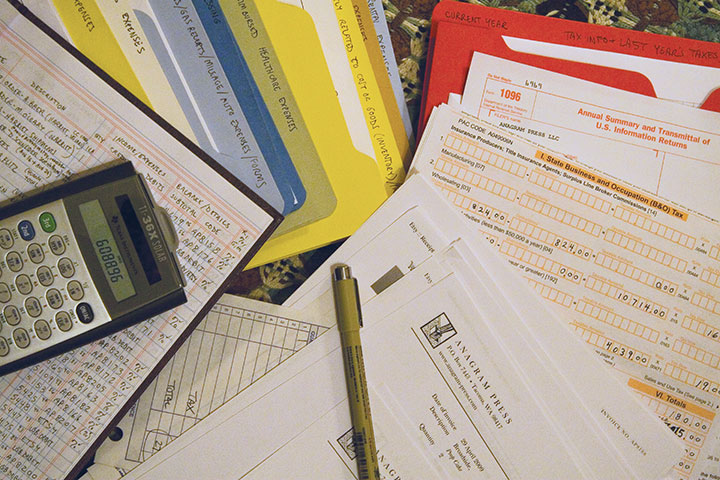
Thing number 386 that they don’t teach you in art school: how to navigate local business excise tax laws.
My wonderful and brilliant accountant takes care of the heavy lifting of my federal business taxes, but since the deadline to pay the Washington piper falls before the federal paperwork even arrives in the mail, I file my state taxes on my own. To be perfectly honest, I take a kind of perverse pleasure in bean-counting—there’s something satisfying about the annual financial housekeeping rituals of compiling and tallying. But now that I own a business in a state that relies solely on sales tax revenue, business excise taxes and weird, archaic, late 19th-century property-assessment laws that tax my homemade bookshelves and vintage filing cabinets (I kid you not), the annual tax ritual has turned into an entire weekend curled up with my calculator.
Since I’m obviously a tax-happy liberal gal who loves her some socialist blueberries (not to mention public libraries and paved roads), I’m perfectly glad to fork over the revenue—I’d just love it if they’d just levy an income tax instead, and spare me (and all those poor state employees) the paperwork nightmare!
Political grumblings aside, I’m just chalking this up to All Those Really Important Things You Have to Learn on Your Own When You Start a Business. I’ve got some fun stuff to share with you, but I’ve gotta get this stuff done first. In the meantime, playing in my head over and over again is that little diddy Bobby McFerrin sang on Square One: “Anything you wanna be, you’ve got to know math.”
So true, Bobby. So true.
January 10th, 2010

I find I’m spending more time at the drafting table these days, and far fewer hours chained to the computer. This month I am blessed with an assistant—a brilliant young woman who is helping me with my administrative and production work, in exchange for school credit, a little professional experience and the chance to beef up her design software skills.
We’re lucky to have here in T-town an arts-magnet public high school, and part of the curriculum for juniors and seniors is an internship opportunity during the winter term. I was completely ignorant of this until I received Zooey’s email last fall, asking if I would be willing to take her on. I almost turned her down, simply because I couldn’t imagine I’d have enough to keep her busy and interested for three 40-hour weeks.
But then it occurred to me that I might be able give her an accurate idea of what it’s actually like to make one’s living as a full-time artist—which largely consists of being one’s own secretary, account manager, bean-counter, marketing department, production assistant and gopher, as well as coming up with all the creative ideas. That’s something I wish I had known as a student, and yet was certainly never taught in art school.
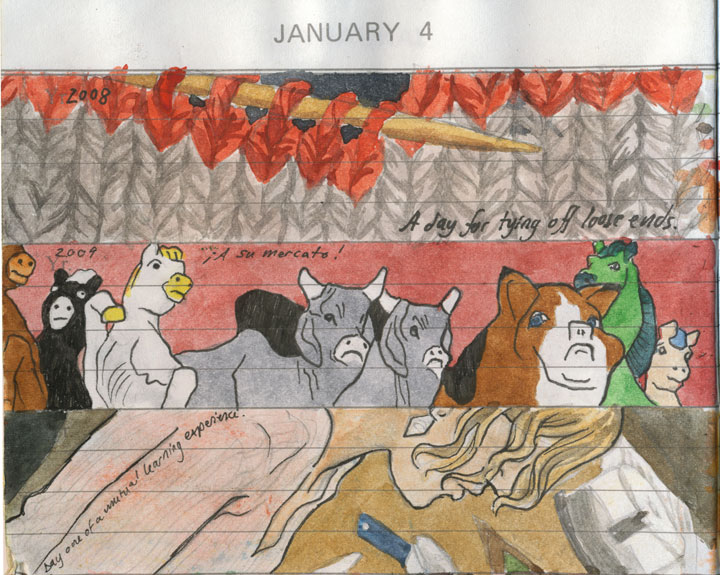
As it turns out, there’s plenty of work for both of us, and it’s been a mutual learning experience. Zooey (not her real name, in keeping with my little privacy policy) is picking up design skills they aren’t teaching at the high school level, attending client meetings and press checks, learning the ins and outs of seeing a project from concept to completion, and contributing her own ideas to creative discussions and brainstorming sessions. And I’m able to spend more time actually creating artwork, rather than endlessly playing catch-up with back-burner projects that should have been done months ago (although I crossed my heart and made her a solemn vow that I would get my own damn coffee).
The best part is having good company during the day. Running a one-woman shop is pretty solitary work, and learning that Zooey is not only a talented artist but also a mutual audiophile and movie geek made her an instant kindred spirit. (It was funny to discover that we both have a habit of singing along with the background music, but often choose different vocal parts to follow: harmony is so much more fun than a solo.) So these days I’m churning out new work and ideas faster than ever, while Zooey keeps a hand on the metaphorical wheel—and all the while the studio is filled with music and laughter.
I’m a control freak by nature, so I’m pleasantly surprised to find myself capable of letting go of the reins a bit. And I was even more surprised to learn that Zooey is the only student working with an individual artist this year (everyone else is working with firms or large companies). Here’s hoping that other artists and freelancers open their doors and minds to future students—there’s so much to learn, on both sides.

November 20th, 2009
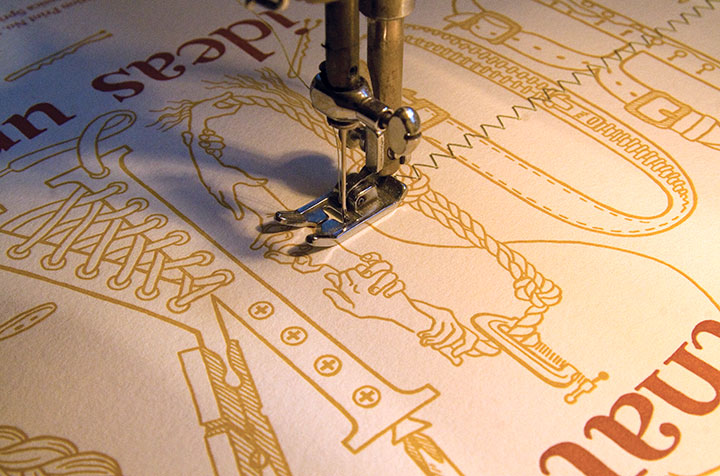
People who stop by the house for the first time must really think I’m strange. Never mind our own personal farmers market residing in the attic and root cellar—these days the place looks like the the visual-art equivalent of Willy Wonka’s Chocolate Factory, with snips of paper, rows of identical bird portraits, bright watercolor cakes, brushes and pencils, boxes of envelopes, shipments waiting to go out, and stacks of prints covering every horizontal surface. It certainly gives new meaning to the term “cottage industry.” I guess that’s what happens when you decide to double your inventory right before the holidays.
This week, though, there was a new element to the chaos: the drone of the sewing machine. And now that all the threads are tied off, Jessica and I are finally ready to unveil a little secret we’ve been sitting on for a few months. Seattle Center for Book Arts (SCBA) asked us to create their second-annual Special Edition Print, and I’m happy to report that they’re now available for sale.

Each year the Special Edition Print has the theme of “Unbound,” and the folks at SCBA challenged us to interpret it how we liked. So instead of our customary work with famous quotes, Jessica whipped up a little gem of her own. We started thinking about all the ways something (not just a book!) might be bound or unbound, which led us to visions of lacing, pinching, tying, zipping, braiding, taping, clamping, buttoning, stitching, buckling, hammering, gluing, clipping, lashing and pinning. Which then, of course, gave me free reign to make an absolute, giddy mess of things, and scatter fasteners and notions all over the page. My favorite additions to the drawing, though, are the bread tags. My grandmother had a whole drawer full of them in her kitchen (did she ever use them, or did I just discover the source of my pack-rat tendencies?), and I loved the way they rattled around in there. So Nana, this one is for you.
Everything is hand-drawn and lettered (as per usual), then letterpress printed in copper ink and an ochre color that is precisely the shade of those little Bit o’Honey candies (remember those?). This time, though, we’ve added a little extra goodie: a line of zig-zag stitching in cotton thread, in exactly the green of copper patina. SCBA is the only place to get these prints, so if you’d like to play a little game of Button, Button, Who’s Got the Button, you can get your copy here.

![Chandler O'Leary [logo]](https://chandleroleary.com/wp-content/themes/chandleroleary/images/logo.png)






















































